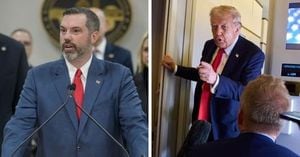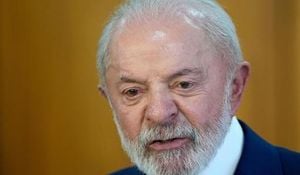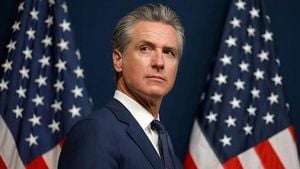WASHINGTON — Donald Trump recently emphasized his election victory came largely due to voter frustration over inflation and grocery prices, stating, "When you buy apples, when you buy bacon, when you buy eggs, they would double and triple the price over a short period of time," during his interview on NBC’s “Meet the Press.” With this focus, Trump pledged to combat rising consumer costs, but critics argue his initial actions don’t directly address inflation.
Shortly after assuming office, Trump signed numerous executive orders aimed at multiple issues; he steered clear of immediate actions targeting consumer prices, aside from directing federal agencies to initiate appropriate actions. An observable shift is noted where his emphasis is largely on energy costs and immigration policy, which he called his “No. 1 issue.” The President is attempting to ease energy prices, which he believes will lead to lower costs throughout the economy.
Critics are concerned about the lack of urgency surrounding inflation. Andy Beshear, Governor of Kentucky, commented, “What I’ve seen out of his executive orders are him addressing everything but inflation and prices,” during his CNN appearance. Beshear, aligning with several economists, warned of potential tariff ramifications, stating, “Doing the math is going to be important if Donald Trump is going to fulfill his campaign promise to lower prices.”
Despite these warnings, Trump remains determined to tackle energy prices, aiming to alleviate broader inflation concerns. A recent rally highlighted his disdain for former President Biden, whom Trump blames for allowing inflation to flourish. "When I think of (former President Joe) Biden, I think of incompetence and inflation," Trump stated, distancing his administration from the former president’s economic policies.
Current inflation figures have fluctuated significantly, peaking at 9.1% annually during summer 2022 due to pandemic-related disruptions. While consumer prices have begun to level off since then, recent data indicate new increases, from 2.4% in September to 2.9% by December. Trump’s plans, such as proposed tariffs against Canada, Mexico, and China, might generate additional inflationary pressure and prevent interest rates from decreasing, according to multiple economic experts.
JD Vance, the Vice President, defended the White House's progress, asserting, “Prices are going to come down, but it’s going to take a little bit of time, right?” He added, “Rome wasn't built in a day,” emphasizing the prolonged nature of economic recovery and price stabilization.
Despite the push for change, it remains to be seen how successfully Trump can navigate inflation challenges. Questions about whether he could motivate oil companies and foreign suppliers to ramp up production without cutting their profits are growing. The Energy Information Administration reported enhanced U.S. domestic oil production, reaching about 13.5 million barrels daily as of October, potentially increasing to even broader figures under Trump's administration.
Economic analysts continue to caution against over-reliance on fossil fuels and tariff impacts on local prices. Although EJ Antoni of the Heritage Foundation mentioned, "If you’re going to bring down the cost of energy, you’re going to bring down the cost of all kinds of goods and services," the concerns about worsening inflation via tariffs and regulatory measures remain prominent among economists.
Many Democrats, including Sen. Chris Murphy, are poised to leverage Trump's focus away from inflation as proof of disconnect with working-class voters. They highlight concerns about immigration reforms overshadowing economic discourse, hoping to regain footholds lost since Trump’s election. “It’s catnip and it causes everybody to stop paying attention to their actual economic agenda,” Murphy remarked, reflecting broader Democratic anxieties about Trump's approach.
With his focus redirected sharply toward immigration and culture war matters during his early administration, Trump’s economic strategies—and their effectiveness—remain to be observed. Potential consequences linger as the legislative process may need broad outreach to Congress to support economic improvements amid shifting consumer sentiments.
Therefore, as Trump proceeds with his plans, the real challenge may be getting diligent math and effective collaboration with Congress right to deliver on consumer price promises made during his campaign. The wait continues now—will voters see substantial efforts to mend economic strains alongside Trump’s fervent immigration conversation?



